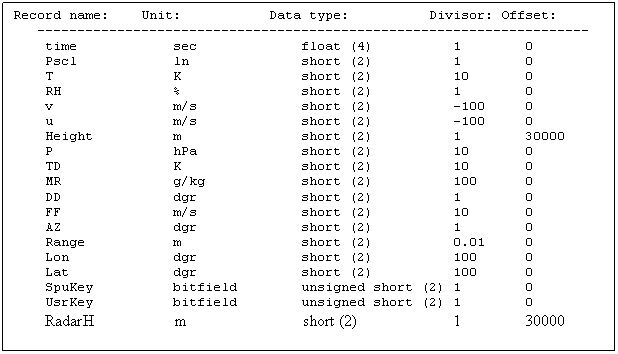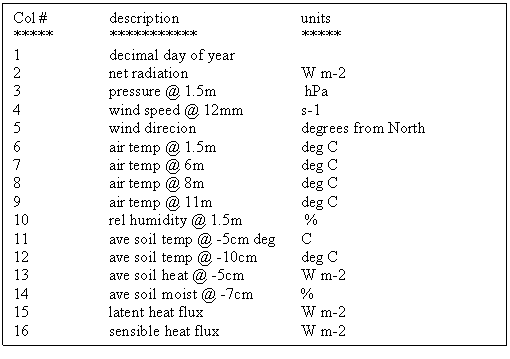NAMMA Senegal Radiosonde and Tower Flux
Table of Contents
Introduction
Radiosonde Data
Radiosondes (Vaisala ®, model RS92-SGP) were released 0-6 times daily during the NAMMA field campaign between August 19 and September 16, 2006, resulting in 72 successful launches over the course of the field campaign. All launches took place at the NAMMA field site in Kawsara, Senegal. Sondes were held at the surface for approximately 5 minutes prior to launching to ensure that accurate surface conditions were being acquired. The average final altitude of the radiosondes was about 20 km (58 reached above 15 km, 47 reached above 20 km). Temperature, pressure, relative humidity, wind speed, and wind direction were recorded every 2 seconds during each ascent. When possible, sondes were strategically released to capture the characteristics of the boundary layer before, during, and after storm events. Knowledge of oncoming storms came from the NASA NPOL radar (also located at Kawsara). Launches were also frequently scheduled to correspond with the overpass times of the Tropical Rainfall Measurement Mission (TRMM) satellite.
Flux Data
Meteorological and flux observations were made from a 12 m guyed, triangular tower (Table 1, below). Power for the computer, data acquisition systems, and instruments were fed from a 30 m extension cord from the shipping container. A gasoline generator powered the shipping container and tower. The field site is co-located with the NASA NPOL radar in the village of Kawsara, Senegal (14.5 N, 17.08 W). The vegetation consists of two layers: a sparse overstory of 1-3 m shrubs and understory of herbaceous grasses less than 1 m tall. The site is less than 200 m from a highway and is grazed by the village goats and nomadic herds of cattle. The observation period ran from 21 August 2006 (DOY 233) to 17 September 2006 (DOY 260). Data was collected using two dataloggers (Campbel Sci 23x and CR3000) connected to a laptop computer. Data for most instruments was averaged over one minute and files were written every 30 minutes. The eddy covariance instruments recorded data at 10 Hz. Due to issues with power at the site, there are 15 days with 24 hours of observations and another 9 have partial data.
Campaign
These data files were generated during support of the NASA African Monsoon Multidisciplinary Analyses (NAMMA) campaign, a field research investigation sponsored by the Science Mission Directorate of the National Aeronautics and Space Administration (NASA). This mission was based in the Cape Verde Islands, 350 miles off the coast of Senegal in west Africa. Commencing in August 2006, NASA scientists employed surface observation networks and aircraft to characterize the evolution and structure of African Easterly Waves (AEWs) and Mesoscale Convective Systems over continental western Africa, and their associated impacts on regional water and energy budgets. For more information about the NAMMA Campaign, go to the NAMMA web site: http://namma.nsstc.nasa.gov/
Data Collection
Radiosonde Data
A radiosonde is just like a dropsonde, except it is not dropped from an airplane, it is launched upward into the atmosphere using a balloon. The instrument measures temperature, pressure, relative humidity, wind speed, and wind direction. These measurements were recorded every 2 seconds during each ascent.
The radiosonde transmits its data to a ground-based telemetry system (antenna and receiver). This telemetry system receives the signals and forwards them to another module (signal processing system) to be decoded into meteorological units. Data are then passed to a computer for collection of data for the entire sounding and formulation of the observation products. the radiosonde type used was Vaisala ®, model RS92-SGP.
Flux Data
Fluxes of carbon dioxide, water vapor, momentum, and sensible heat are measured by the eddy covariance technique using high response instruments at 10 Hz (Table 1). Vertical air temperature profile was measured at 5 levels above ground using fan-ventilated thermistors. Radiation measurements for incoming and outgoing shortwave, longwave, and photosynthetically active radiation (PAR) were made at 9 m above the surface. Incoming ultraviolet radiation was measured on a separate boom about 5 m from the tower. Below ground measurements (temperature, moisture, and soil heat flux) were taken at two areas (below vegetation and below bare soil); data provided gives the average value.
TABLE 1. FLUX TOWER MEASUREMENTS AND COMPONENTS
| Measurement (units) |
Levels (m) |
Manufacturer/Model |
| Air Temperature ( deg C) |
1.5, 3.5, 6, 8, 11 |
R.M. Young / 41342 |
| Relative Humidity (%) |
1.5 |
R.M. Young / 41382 |
| Wind Speed (m s -1) and Direction (degrees from North) |
12.3 |
R.M. Young / 5103 |
| Atmospheric Pressure (mb) |
0.5 |
Viasala / PTB101B |
Radiation:
Incoming Shortwave (W m -2)
Incoming Longwave (W m -2)
Outgoing Shortwave (W m -2)
Outgoing Longwave (W m -2)
Photosynthetically Active (W m -2)
Ultraviolet (W m -2) |
9
9
1 |
Kipp and Zonen / CNR-1
LI-COR / LI-190SA
Eppley / TUVR |
Wind Speed in Three Dimension (m s -1) |
7.25 |
Applied Technologies / SATI-3SX |
H 2O/CO 2 concentration (mmol m -3) |
7.25 |
LI-COR / LI-7500 |
Soil Temperature ( deg C) |
-0.05, -0.1 |
Campbell Sci. / 107 |
Soil Moisture (%) |
-0.07 |
Campbell Sci. / CS616 |
Soil Heat flux (W m -2) |
-0.05 |
Radiation and Energy Sys. / HFT3 |
File Naming Convention
There are three types of files associated with the Senegal radiosonde data:
Raw data, in tab separated values (tvs) format
Processed data, in ASCII text format
Browse profile, in JPEG (Joint Photographic Experts Group) format
Examples of the radiosonde files found in this dataset are listed below:
namma_senegal-sonde_20060824_0006_proc.txt
namma_senegal-sonde_20060824_0006_prof.jpg
namma_senegal-sonde_20060824_0006_raw.tsv
where, 20060824 is the date of the radiosonde launch, and 0006 is the the time of the launch (hhmm).
There is one file per day for the Senegal flux data. Data for most instruments on the flux tower were averaged over one minute periods, and files were written every 30 minutes.
An example of one of the flux data files is shown below:
namma_senegal-flux_20060824_30minave.txt
where, 20060824 is the date of the data, and 30minave shows that the data are averaged and recorded in 30 minute intervals
Data Format and Content
Radiosonde Data
These processed data text files (.txt) contain radiosonde data collected by University of Virginia
and Howard University during NAMMA 2006. Data were processed at University of Virginia.
Questions concerning this data can be directed to Marcia DeLonge
at University of Virginia: msd8y@virginia.edu.
The data are arranged in the following columns:
1) altitude(m)
2) Virtual Pot. Temp(K)
3) Equivalent Pot. Temp (K)
4) Specific Humidity, q (g/kg)
5) Dew Point Temperature (K)
6) Relative Humidity (%)
7) Wind Velocity (m/s)
8) Wind Direction (degrees)
Sample data file:

The raw radiosonde data files are ASCII data files, and are in tab separated value (tsv) format. The chart below describes the the thirteen columns of data in these files. Additional information can be found in each file header.
TABLE 2. SENEGAL RAW RADIOSONDE DATA FORMAT

There is also a browse product for each radiosonde launched, in jpg format. These files plot the radiosonde data in a graphical format, and are quite useful for quick look information.
Flux Data
The Senegal Flux Tower data files were collected and processed by University of Virginia. These data files are ASCII text files in column format, with each column identified by the chart below.
TABLE 3. SENEGAL TOWER FLUX DATA FORMAT

Contact Information
Questions related to these data should be directed to the data providers listed below:
Radiosonde Data:
Marcia DeLonge
msd8y@virginia.edu
Flux Data:
W. Stephen Chan
wsc4j@virginia.edu
To order these data or for further information, please contact:
Global Hydrology Resource Center
User Services
320 Sparkman Drive
Huntsville, AL 35805
Phone: 256-961-7932
E-mail: support-ghrc@earthdata.nasa.gov
Web: http://ghrc.nsstc.nasa.gov/
|

